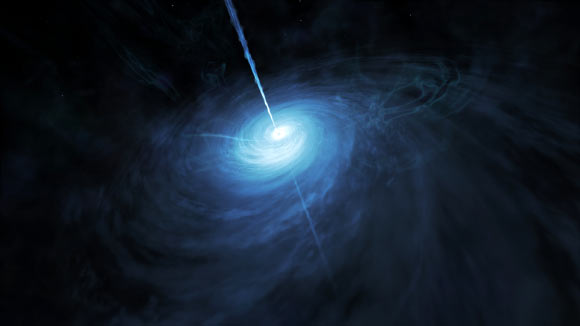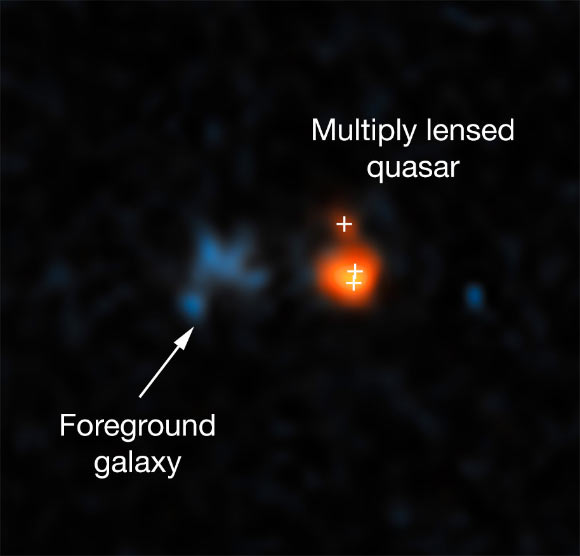Astronomers using the NASA/ESA Hubble Space Telescope have spotted the brightest quasar ever seen in the early Universe.

Less than a billion years after the Big Bang, a supermassive black hole began devouring anything within its gravitational grasp; this triggered a firestorm of star formation around the black hole; a galaxy was being born; a blowtorch of energy blazed across the Universe. Now, 12.8 billion years later, the NASA/ESA Hubble Space Telescope captured the beacon from this event. But the telescope needed help to spot it: the gravitational warping of space by a comparatively nearby intervening galaxy greatly amplified and distorted the quasar’s light, making it the brightest such object seen in the early Universe. Image credit: NASA / ESA / Hubble / M. Kornmesser.
Quasars are the extremely bright nuclei of active galaxies.
The powerful glow of a quasar is created by a supermassive black hole which is surrounded by an accretion disc. Gas falling toward the black hole releases incredible amounts of energy, which can be observed over all wavelengths.
The brightness of the newly-discovered quasar, named J043947.08+163415.7 (J0439 for short), is equivalent to about 600 trillion Suns and the supermassive black hole powering it is several hundred million times as massive as our Sun.
“That’s something we have been looking for for a long time. We don’t expect to find many quasars brighter than that in the whole observable Universe,” said Dr. Xiaohui Fan, an astronomer at the University of Arizona.
“This detection is a surprising and major discovery; for decades we thought that these lensed quasars in the early Universe should be very common, but this is the first of its kind that we have found,” said Dr. Fabio Pacucci, a postdoctoral researcher at Yale University.
“It gives us a clue on how to search for ‘phantom quasars’ — sources that are out there, but cannot be really detected yet.”

This image shows the distant quasar J043947.08+163415.7 as it was observed with the NASA/ESA Hubble Space Telescope. The quasar is one of the brightest objects in the early Universe. However, due to its distance it only became visible as its image was made brighter and larger by gravitational lensing. The system of the lensed images and the actual lens is so compact that Hubble is the only optical telescope able to resolve it. Image credit: NASA / ESA / X. Fan, University of Arizona.
Despite the quasar’s brightness Hubble was able to spot it only because its appearance was strongly affected by strong gravitational lensing.
A dim galaxy is located right between J0439 and Earth, bending the light from the quasar and making it appear three times as large and 50 times as bright as it would be without the effect of gravitational lensing.
The Hubble data show not only that the supermassive black hole is accreting matter at an extremely high rate but also that the quasar may be producing up to 10,000 stars per year.
“Clearly, this black hole is not only accreting gas, but has a lot of star formation around it,” said Dr. Jinyi Yang, an astronomer at the University of Arizona.
“However, because of the boosting effect of gravitational lensing, the actual rate of star formation could be much lower than the observed brightness suggests.”
“Its properties and its distance make it a prime candidate to investigate the evolution of distant quasars and the role supermassive black holes in their centers had on star formation,” added Dr. Fabian Walter, from the Max Planck Institute for Astronomy in Germany.
Quasars similar to J0439 existed during the period of reionization of the young Universe, when radiation from young galaxies and quasars reheated the obscuring hydrogen that had cooled off just 400,000 years after the Big Bang; the Universe reverted from being neutral to once again being an ionized plasma.
However, it is still not known for certain which objects provided the reionizing photons. Energetic objects such as J0439 could help to solve this mystery.
The discovery is reported in the Astrophysical Journal Letters.
_____
Xiaohui Fan et al. 2019. The Discovery of a Gravitationally Lensed Quasar at z = 6.51. ApJL 870, L11; doi: 10.3847/2041-8213/aaeffe







